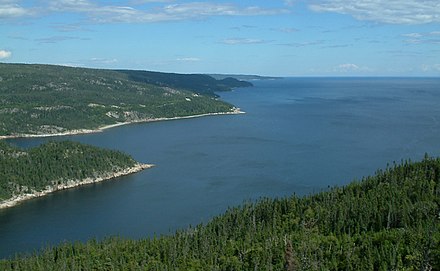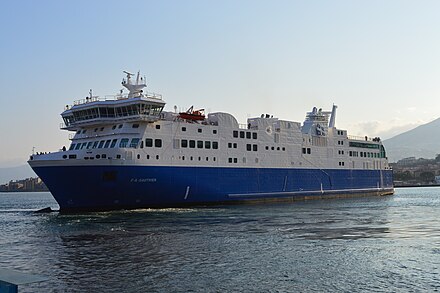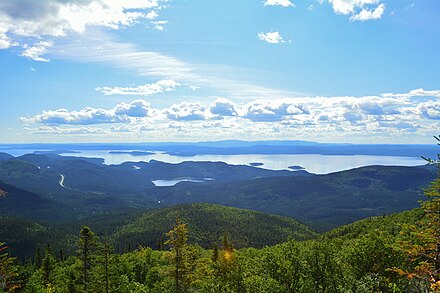Manicouagan
Manicouagan

Understand
It includes the regional county municipalities (RCM) of Manicouagan and La Haute-Côte-Nord, whose main cities are respectively Baie-Comeau and Forestville. The region is located on the north side of the St. Lawrence River and the inhabited part is mainly located along the coast. It has a population of approximately 45,500 inhabitants. The main economic activity of La Haute-Côte-Nord is tourism, while the MRC of Manicouagan is known for its hydroelectric production. The name "Manicouagan" is borrowed from the river of the same name located in the region.
With the coast that overlooks the magnificent St. Lawrence River, the cliffs that frame the imposing Saguenay Fjord, the salt marshes where you can observe 175 species of birds, the migratory passes where salmon leap, the whales that swim in the river and without forgetting the boreal forest, the tundra, the bubbling rivers and the deep lakes of its hinterland, the Manicouagan region is definitely pampered by nature! This grandiose setting gave birth to a hydroelectric empire where the largest multiple-arch dam in the world, the Daniel-Johnson dam (Manic-5), reigns supreme. Suitable for hiking, camping, scuba diving, sea kayaking, hunting, fishing and snowmobiling, this region covers a vast territory of wilderness that will charm outdoor enthusiasts with clean air, wide open spaces and authenticity.
There is a permanent tourist information office in Baie-Comeau and seasonal offices in Tadoussac, Bergeronnes, Escoumins, Longue-Rive, at Portneuf-sur-Mer, at Forestville, at Ragueneau on the Manicouagan Peninsula, at Baie-Comeau, in Godbout and in Port-Cartier.
Cities
- Baie-Comeau 📍 — Main city of the MRC of Manicouagan, at the crossroads of the road to the north for Fermont and connected with the south coast of the St. Lawrence River by a ferry.
- Forestville 📍 — Main city of the RCM of La Haute-Côte-Nord, member of the Fédération des villages-relais du Québec. A popular spot for hunting and fishing.
- Pointe-aux-Outardes 📍 — Small village located between Tadoussac and Baie-Comeau known for bird watching. Ornithology enthusiasts will find more than 200 species of birds there. Boardwalks have been constructed along the shoreline for bird watching. The Longue-Rive Salt Marsh Interpretation Center is also a good destination since Canada geese (known locally as bustards) and greater snow geese stop there during their migrations.
- Tadoussac 📍 — Gateway to the region by car, is part of the Association of the Most Beautiful Villages of Quebec. In addition, Tadoussac Bay is part of the club of the most beautiful bays in the world. It is therefore an essential destination when visiting the region. Located on the edge of the Saguenay-St. Lawrence Marine Park, Tadoussac is an ideal starting point for marine mammal observation excursions.
Other destinations
- Île René-Levasseur 📍 — Second largest island in Quebec, located in the Manicouagan reservoir, created by the rising waters following the construction of the Daniel Johnson dam, includes two protected areas.
- Louis-Babel Ecological Reserve 📍 — The largest ecological reserve in Quebec, includes the northern part of Rene-Levasseur Island as well as the summit of Mount Babel.
Get in

By car
You can reach the region by car from the southwest by taking the route 138. It begins at the US border with New York State (where it becomes New York State Highway 30) to the south-west of Montreal and runs along the St. Lawrence River to Natashquan. However, you can use different routes up to Quebec (Highway 20 or Highway 40 for example). From Quebec, the region is approximately by road, or a trip of 3½ hours by car. You can also to reach route 138 from Rivière-du-Loup in Bas-Saint-Laurent (accessible by route 132) by taking the ferry Trans-Saint-Laurent linking Saint-Siméon in Charlevoix (capacity of 399 people and 100 cars and crossing lasting 65 minutes). By taking route 138, you will enter the region at Tadoussac. Route 138 has a ferry between Baie-Sainte-Catherine in Charlevoix and Tadoussac to cross the Saguenay Fjord. The crossing is free for passengers and vehicles and takes approximately 10 minutes. It is not necessary to reserve and the service is offered year-round.
You can reach Manicouagan from Saguenay–Lac-Saint-Jean by taking Route 172 which leads to Tadoussac. Route 172 is mostly in a park, so there are no gas stations along the route, in addition to cell signal which is mostly non-existent.
You can reach the region by car by taking the Camille-Marcoux ferry from Matane on the Gaspé peninsula (see the section By Boat below).
By bus
- Intercar, +1 418-665-3443. Intercity bus between Quebec City, Baie-Comeau, Sept-Îles et Havre-Saint-Pierre. 2022-07-21
By boat


- Ferryboat Godbout-Matane via the boat "Camille-Marcoux", gare fluviale de Godbout: 117, rue Pascal-Comeau, Godbout (at the wharf in the village of Godbout), 49.32294°, -67.59329°, +1 418-562-2500. throughout the year. The N.M. F.-A. Gauthier is the largest vessel of the Société des traversiers du Québec with a capacity of 800 people and 180 cars. It offers one to two round trips per day depending on the time of year. The crossing takes more than two hours. The ship offers a catering service, a bar and an exhibition room. It is recommended to make your reservation in advance. This is mandatory for vehicles. 2022-07-20
- Compagnie de navigation des Basques. Crossing with the Bas-Saint-Laurent, L'Héritage makes the crossing between Trois-Pistoles and Les Escoumins. The journey time is 1½ hours. This service is only offered from May to October. 2022-07-20
- CNM Évolution. Crossing between Rimouski and Forestville. This is the fastest ferry in Quebec, it makes the crossing in one Hour. 2022-07-20
A few marinas along the river, including that of Tadoussac, allow nautical travelers to dock to visit the region.
By plane
The Baie-Comeau airport (10 minutes from the city) is served by a few airlines including Air Liaison, Air Canada Jazz and Pascan Aviation. It can be quite expensive to fly between small airports in Quebec, so it is advisable to compare with other means of transport before booking a flight.
Get around
By car
Route 138 is the main highway in the region. It follows the coast of the St. Lawrence River throughout the region between Tadoussac to the west and Baie-Trinité to the east.
By quad or snowmobile
Networks of quad and snowmobile trails also allow you to travel in the region in off-road vehicles while allowing you to discover the backcountry and its impressive landscapes. The trails go to gas stations as well as restaurants and accommodation establishments, so you can also visit the region by snowmobile!
- Manicouagan snowmobile trail map 2012-2013 (Carte des sentiers de motoneige de la Manicouagan 2012-2013), +1. 2022-07-20
Routes
By car
- [Route des Baleines](http://www.quebecmaritime.ca/fr/planifiez-votre-voyage/circuits-touristiques/la-route-des-baleines?gclid=CNDWutL7xbYCFY1DMgodDG0AHw), +1. Circuit that crosses the region over 300 km on the coast of the St. Lawrence between Tadoussac and Baie-Trinité. Cruises are organized for waching marine mammals including blue whales, belugas and rorquals. In fact, there are 13 different species of whales in the Estuary and Gulf of St. Lawrence. It is also possible to observe them by sea kayak or even from observation sites on the shore. In addition, there are seals all along the coast. Marine mammals mainly frequent the region from May to October. 2022-07-21
By snowmobile
- Raid nordique, +1. 2022-07-21
- Raid du Saint-Laurent, +1. 2022-07-21
Talk
The language spoken in Manicouagan is French. It will be possible to make yourself understood in English language in most tourist places. Manicouagan also includes a little more than Indigenous people, of whom approximately speak their Indigenous language, mainly Innu-aimun, in addition to French or English.
See
Do


The region is known for outdoor activities and ecotourism. Sea excursions, cruises or kayaks, are obviously a must in order to fully enjoy the region and observe the whales. Scuba diving enthusiasts will also be well served with the aquatic fauna and flora of the St. Lawrence River as well as some wrecks. Thanks to its strong winds, the area is very popular for kitesurfing.
During the winter season, packages for dog sledding, ice climbing and Nordic skiing are offered. Outfitters also offer ice fishing packages including stays in cabins. Several cross-country ski trails run through the region. Moreover, the Boréal Loppet Hydro-Québec is a cross-country ski competition organized each year at the beginning of March for both athletes and families. There is also a very well signposted network of snowmobile trails that includes some pretty impressive walkways. In Baie-Comeau, a ski centre offers 14 slopes of different levels for downhill skiing and other sliding sports.
The Manicouagan is a fishing paradise for both Atlantic salmon and brook trout (known locally as speckled trout). In addition to many outfitters offering hunting and fishing packages including accommodation, the region has four controlled harvesting zones (ZEC) that will meet the needs of hunting and fishing enthusiasts.
At this height, the St. Lawrence River forms a real sea and several fine sandy beaches are present to enjoy and swim. Find out about the tides before venturing along the river to avoid unpleasant surprises.
 The Manicouagan includes several hiking trails such as the Pointe Saint-Gilles trail in Baie-Comeau, which has sculptures and interpretive panels along its route. It is also possible to go horse riding or cycling. The Monts Groulx are a good destination for lovers of trekking and wilderness.
The Manicouagan includes several hiking trails such as the Pointe Saint-Gilles trail in Baie-Comeau, which has sculptures and interpretive panels along its route. It is also possible to go horse riding or cycling. The Monts Groulx are a good destination for lovers of trekking and wilderness.
Quad biking (called VTT, or all-terrain vehicle, in Quebec) is a popular activity in the region. A well-signposted network of trails allows you to discover the region and observe the landscapes of its hinterland.
For golf enthusiasts, there are four 9- or 18-hole golf courses in Manicouagan. The Tadoussac golf club has a magnificent view of the Saguenay Fjord while the Forestville golf club overlooks the St. Lawrence River. The other two clubs are located in Baie-Comeau and Pointe-aux-Outardes.
Eat
Several small markets and grocery stores offer a unique chance to taste local products. Fish and seafood are the culinary specialty of the region, including some that are more unusual such as sea urchin. The period from March to October is ideal for taking advantage of the daily fresh produce from the fishmongers that dot the entire region. It is also possible to find local game served in the many restaurants in Manicouagan.
Accommodation
The area has a variety of accommodation types. Several campsites are available for camping in caravans or tents. Some, including those in Tadoussac and Cap-Bon-Désir, are located directly on the shore of the St. Lawrence, allowing you to fall asleep to the sound of whales! The area also includes lodges, hotels and inns. Some outfitters also offer cabin accommodation in their packages.
Buy
Stay safe
Cope
- Emergency number (Numéro d'appel d'urgence), 911. Others numbers: Maritime distress (French: Détresse maritime) +1-800-463-4393; Poaching: +1-800-463-2191 2022-07-21
Go next
From Manicouagan, you can visit the rest of the Côte-Nord, which is part of the tourist region of Duplessis to the east. To the west, we find the Charlevoix, which is an important tourist destination. It is also possible to go to Saguenay–Lac-Saint-Jean. In addition, by crossing the St. Lawrence River, one can reach the regions of Bas-Saint-Laurent and Gaspésie.